

Bottle Dating |
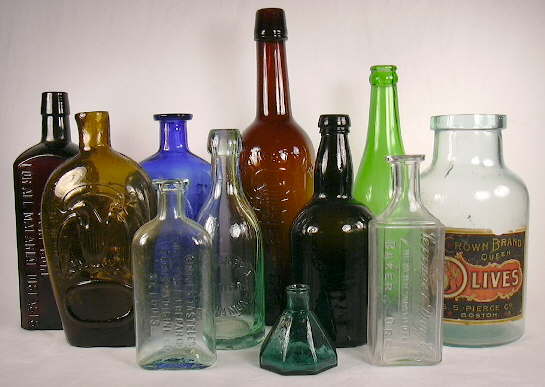 HOME: Bottle Dating
HOME: Bottle Dating
INTRODUCTION
This page and associated sub-pages allows a user to run an American produced utilitarian bottle or a significantly sized bottle fragment(s) through a series of questions based primarily on diagnostic physical, manufacturing related characteristics or features to determine the approximate manufacturing age range of the item. As Berge (1980) noted in referring to bottles, the "...mode of manufacture of glass containers provides observable attributes which seem to be very useful in a classification of these artifacts." Thus, this page.
This bottle dating "key" is a relatively simple "first cut" on the dating of a bottle. While running a bottle through the key questions, the user is frequently directed to move to other website pages to explain diagnostic features and concepts as well as to add depth and/or precision to the initial dating estimate. Please be aware that in order to gain the maximum information about any particular bottle (e.g., dating, typing) the user must usually review a number of pages within this website.
Unfortunately, the complexities of precisely dating bottles is beyond the scope of any simple key; more complex keys are far in the future if they ever become available. A substantial amount of bottle type specific information must be reviewed by a user to increase the probability of dating accuracy. Additional reference materials outside of this website must usually be consulted to narrow down the date of any item as far as is possible and to really get a "feel" for the history of the bottle in question. Additional reference materials include: bottle type or location specific bottle books and experts; period business directories; period newspapers, magazines and other printed publications; local, state or regional historical societies, museums, libraries, and colleges/universities; and others this author is forgetting.
Fortunately, as each year passes more of this type information becomes available on the internet. Since this website was initiated (2002) a simple search for a bottle can now yield much more information than back then, depending on the precision and wording of a search. This admittedly can be very challenging with bottles that have no company, user, or bottle maker related embossing or original labeling. The information on this website will, however, usually produce a reliable manufacturing date range for a majority of American utilitarian bottles manufactured from the late 17th century to the mid-20th century.
Click here to move directly to the "Dating a Bottle" Section below.
For the first time user of this site it is highly recommended that
the following information be read prior to using the key below.
1. Like many industries making the leap from manual craftsman production to industrialization and automation, technological advances in bottle manufacturing were not immediately accepted by glass manufacturers or their workers. Acceptance often occurred over a period of many years or decades in some cases. This technology lag makes some diagnostic characteristics better than others for dating. This will be noted where known. 2. As a corollary to #1, consider the following quote: "Treat terminal dates with care. We can always have some indication of a starting date for a technique if we can find who first put the idea into practice. But any technique, once developed, can be used right up to the present - as many collectors know who have been so unfortunate as to rely too heavily on a popular termination date as sure evidence of true antiquity..." (Toulouse 1969b). In short, there was (and is) nothing to stop a glassmaker from using an obsolete method in the production of a bottle. 3. Some technological changes were expensive and not adopted by glass makers until it became an "adapt or perish" issue and many glass factories simply perished. The shift to the fully automated bottle machine from mouth-blown and some semi-automatic methods in the early 20th century is the classic example (Toulouse 1967, 1969a). (See the Glassmaking & Glassmakers page)
Reuse, of course, does not change the manufacturing date of the bottle itself, but care must be exercised when using the known date of one or a few bottles to date other items found from the same context. When a likely or known "older" item is found in a known "newer" site it is referred to as deposition lag. An example of this is the finding of a few pontil scarred utilitarian bottles among otherwise late 19th or early 20th century refuse. It is unlikely that this bottle was made during the same era, but instead was reused for a lengthy period or otherwise retained until broken or discarded. Pontiled base fragments could also be from later produced "specialty" bottles which are described below.
5. Some bottle shapes are indicative of a particular manufacturing era, though many bottle styles/shapes were used for so many years - like the cylinder whiskey "fifth" or square snuff bottle - that the shape itself is not indicative of age. Other diagnostic tools must be used to date these items. Shape is more indicative of function, i.e., what the bottle was used for or contained , though even that can have a myriad of exceptions. See the Bottle Typing/Diagnostic Shapes page for more information on the subject. 6. And last, but definitely not least, is the fact that the art and science of glassmaking had a lot of glassmaker/glassblower induced uniqueness in the form of variations, errors, experimentations, and retrogressions. All this adds to the fascination with bottle making, but makes systematic dating similar to solving Rubik's cube - ostensibly simple on the surface but complex in practice. To misquote an old saying as rephrased by the BLM supervisor that facilitated the initiation of this website project: "The universe (of bottles) isn't just more complicated than you think, it's more complicated than you CAN think." True to a large degree, though much information can be teased out of most bottles with a systematic approach to the matter. That is the point of this website. A yet a few more factors to keep in mind in the dating of bottles...
What is a utilitarian bottle/jar? They are defined as:
Utilitarian bottles include the majority of the bottles in the following bottle categories or types: soda, mineral water, beer, milk, proprietary medicine, druggist (excluding shop furniture), chemical, foods & sauces, household (including ink, shoe polish, cleaners, personal hygiene related items), common wine containers (excluding decanters), champagne, and most non-decanter spirits/liquor bottles. Utilitarian items include canning/fruit jars and figured flasks since they were intended to be reused by the purchaser and have been observed to follow well the dating guidelines, though there are some manufacturing timeframe differences with canning jars. (Click canning jar to view the typology page section devoted to that category.) The heavy glass beer bottle pictured to the above left is a classic example of a utilitarian bottle from the late 19th century which was typically reused but follows the dating guidelines on this and the related dating pages.
|
Having stated the above, there are still many diagnostic features or characteristics that provide a high probability of both dating and typing a bottle with some precision. The more datable diagnostic characteristics that can be used, the closer the date range can be narrowed and/or the more confidence one can have in the range determined.
A key concept in historic bottle dating is the high probability (i.e., high likelihood) that the age range noted for a particular diagnostic characteristic is accurate for a given bottle which has that diagnostic feature. The general probability estimates noted on this website are based on a merging of reliable references with empirical observations made by this site's affiliated consulting experts (see the About This Site page) and the author all of whom have been students of historic bottle dating and identification for many years.
Notes on embossing, labeling, and existing research
Researched historical information of variable depth and quality exists for thousands of different - typically embossed - bottles. Published works generally cover either a particular city, region, or category of bottles. Quality examples of references within each of these three categories are, respectively, Gordon Pollard's (1993) book on Plattsburg, NY bottles (Bottles and Business in Plattsburgh, New York: 100 Years of Embossed Bottles As Historical Artifacts), John Thomas's (1974) book on Western American liquor flasks (Picnics, Coffins, Shoo-Flies), Alice Creswick's (1987) books on canning jars (The Fruit Jar Works - Volume 1 & 2) and David Burton's (2015) monumental 3 volume work on sealed bottles from around the world (Antique Sealed Bottles - 1640-1900). See the References page for more information. For a large majority of embossed and unembossed bottles, however, there is little or nothing formally published on the details of their origins. There were many hundreds of thousands of uniquely different bottles (including differences in the embossing on the same "type" bottle as well as different sizes) produced during the era covered by this website - 1800 to the 1950s - just in the United States. Only a relative few geographic areas or areas of collecting interest have received more than cursory historical treatment and the majority of this is due to the efforts of collectors. Unfortunately, it is likely that the majority of bottles produced during the 19th century have little or no information still existing today that would allow for substantive research. Time has taken its toll on records, of course, but much of what happened in the past was simply not documented well or at all as with most endeavors of common people in the past. As noted in Munsey's 1970 book, "When it comes to methods of dating bottles...history has not been very kind..." Though much research has been done since Munsey's book, relatively little specific information exists about a large majority of bottles. As Munsey also notes - "Most of what is used today to date bottles...is based on assumption and logic and at best is general" (Munsey 1970). Still all true today. All of the dating information on this site, including the following dating key, is based on the researched history and evolution of American glass making, specific glass maker histories, and the above noted regional research on specific - typically embossed - company/product bottles. This body of information will be utilized and extrapolated to make dating (and typing) estimates for the majority of bottles for which there is either no specific company or glass maker information available or such is not possible to determine because the bottles are unmarked (i.e., not embossed) and are no longer labeled. (Note: An excellent reference on the art & science of dating and identifying bottles based on a myriad of different information sources and type collections is found in Bill Lockhart's (2001(d)) article entitled "A New Twist for Uncapping Old Information about Glass Artifacts".) |
This website is designed to have the informational depth, pictures, and illustrations necessary to solve the problems of the Newman key though his warning still holds, although hopefully less so. This entire website is essentially a key to the dating and typing of bottles.
(Note: Cecil Munsey's exceptional 1970 book on general bottle collecting - The Illustrated Guide to Collecting Bottles - included a chapter on "Dating Bottles." It did lack specificity in that it simply used a line chart to show the estimated range for various "Techniques, Tools, and Tool Marks" between 100 B.C. and 1970. However, the author of this site still recommends Dr. Munsey's book as the best overall printed publication on the subject of bottle typology, bottle & glass production, and related subjects. Though long out of print it is still widely available through internet used book sites, eBay®, and in used book stores.)
Before jumping into the key, it must again be emphasized that no single key can get a user to an absolutely precise date for any bottle. The best the following key can do is get a user to a reliably close dating range estimate. Other information on this website usually must be reviewed to fine tune the information about a specific bottle.
In addition, other references beyond the scope of this website usually must be consulted to get as complete of a dating and typing story as is possible for any given bottle. This include period newspapers, business directories, glass makers catalogs, trade journals and related publications, and other sources too numerous to detail.
Keep this all in mind as you progress through the key which follows and on into the other website pages.............good luck!
The "DATING A BOTTLE" Process Starts Here!
The three questions found on this page below answer several basic questions about a given bottle. Answers to these questions will then direct a user to one of the two additional dating pages which are extensions of this key for the two major classes of bottles: mouth-blown bottles and machine-made bottles. Read the questions - and accompanying explanations and exceptions - very carefully as the correct answer is critical to moving properly through the "key." For examples of how to use this dating key see the Examples of Dating Historic Bottlespage. This page guides a user through the key for seven different type and age bottles with several being side-by-side comparisons of very similar bottles of different eras. This page also shows how other portions of this website can provide information pertinent to the bottle in question. This dating key, as noted earlier, is based on a composite of information from many sources, as modified and/or expanded on with the empirical observations of the site author and other experienced individuals whom were consulted. (See the About This Site page for more information about the author and contributors.) The major References that support the construction of this key include Kendrick (1963 & 1968), Toulouse (1967, 1968, 1969b, 1970), Newman (1970), Munsey (1970), Jones (1971), McKearin & Wilson (1978), Zumwalt (1980), Miller & Sullivan (1981), Deiss (1981), Elliott & Gould (1988), Jones & Sullivan (1989), Boow (1991), Fike (1989 & 1998), Thomas (1974, 1998a & b, 2002), Miller & McNichol (2002), Smith (2003), Van den Bossche (2001), Burton (2015), Lockhart (scores of publications & articles) and hundreds of other sources to varying degrees. For brevity, most of the specific references are not noted in the key's narratives. They are noted on the other website pages which expand on the information summarized in the key. If you know your bottle is machine-made If you know your bottle is mouth-blown (aka hand-made) |
QUESTION #1: Does the bottle have raised embossing on the base, body, shoulder, and/or neck OR a distinct vertical side mold seam visible on the body, shoulder, and/or neck (or both features)?
If unsure about what embossing or vertical side mold seams (picture below) are, click on Bottle Morphology to see this sub-page for a illustration and explanation of these and many other key bottle related physical features. Return back to this page by closing the Bottle Morphology page. For expanded information on body mold seams and embossing review the Bottle Body Characteristics & Mold Seams page.
|
Vertical side mold seam on the neck of a beer bottle ending well below the finish, indicating that it was at least partially handmade - ca. 1905-1915. |
YES - The bottle has embossing or visible vertical side mold seams somewhere on the body between the heel and the base of the finish or lip. A bottle may have mold seams but no embossing, but all embossed bottles were molded in some way and have mold seams even if they are not readily apparent. The majority of the bottles made in the 19th and virtually all in the 20th century were made in molds so "YES" is the most likely answer to this question. If so, move to QUESTION #2 below. (See note #2 below if there is embossing but it is only within a disk of glass which appears applied to the neck, shoulder or body of the bottle.)
NO - The bottle has NO embossing and NO apparent vertical side mold seams on the base, body, shoulder, or neck. This bottle is either free-blown, "dip" molded, or was produced in a "turn-mold" (aka "paste-mold") where the side mold seams were erased during manufacture. A "NO" answer is much less likely than "YES" for this question as a very large majority of bottles made during the 19th century and virtually all made during the 20th century were mold blown resulting in mold seams; see the notes below. If you are sure that the answer is "NO", move to QUESTION #3 below.
Notes: 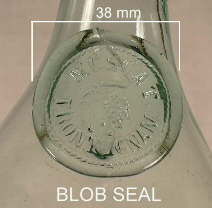 1.A low probability though possible "NO" alternative is that the user has an unembossed, molded bottle with no visible vertical side mold seams. This can be due to one or a combination of factors including post-molding hot glass "flow" masking the mold seams, fire polishing of the bottle body, or atypically good mold part(s) fitting precision. If necessary, look very closely at the bottle shoulder - the best location to see vertical side seams on mouth-blown and most machine-made bottles - in good light with a hand lens to see if there is at least some faint evidence of where the mold part edges came together. Often the vertical side mold seams are evidenced by very faint changes in glass density in lines where one would expect mold seams to be. For additional help review the Bottle Body Characteristics & Mold Seams page.
1.A low probability though possible "NO" alternative is that the user has an unembossed, molded bottle with no visible vertical side mold seams. This can be due to one or a combination of factors including post-molding hot glass "flow" masking the mold seams, fire polishing of the bottle body, or atypically good mold part(s) fitting precision. If necessary, look very closely at the bottle shoulder - the best location to see vertical side seams on mouth-blown and most machine-made bottles - in good light with a hand lens to see if there is at least some faint evidence of where the mold part edges came together. Often the vertical side mold seams are evidenced by very faint changes in glass density in lines where one would expect mold seams to be. For additional help review the Bottle Body Characteristics & Mold Seams page.
2. If the embossing on a bottle is only within a separately applied blob seal similar to that shown to the right (click to enlarge), and found nowhere else on the bottle, the bottle is almost certainly mouth-blown. Click QUESTION #4to pursue more information on the Mouth-Blown Bottles portion of this key (you will move to another webpage). This is another low probability choice but certainly possible.
Bottle DOES Have Vertical Side Mold Seams |
QUESTION #2: Do the vertical side mold seams go up to the highest vertical point of the finish (aka "lip") side and usually onto the finish rim* itself AND the topmost surface of the finish (rim) is not visibly ground down, i.e., the bottle does not have a "ground lip/rim"? (Also see the *Exceptions to Question #2 box below.)
Dating Bottles with the One of the longest running "myths" in the world of bottle dating is that the side mold seam can be read like a thermometer to determine the age of a bottle. The concept is that the higher the side mold seam on the bottle the later it was made - at least in the era from the early to mid 19th century until the first few decades of the 20th century. This dating tool was apparently devised by Grace Kendrick in her 1963 book "The Antique Bottle Collector." This book was pioneering and reprinted many times into the 1970s and is probably the most common and widely quoted (by collectors and archaeologists alike) bottle book ever written, containing a wealth of generally good information. This concept was articulated by Kendrick's in a chapter entitled "The Applied Lip" which contains an "Age Gauge: Mold Seams of Bottles" chart (Figure 9). Kendrick's explains in the text (pages 45-47) that...
The chart accompanying this statement notes that bottles made before 1860 have a side mold seam ending on the shoulder or low on the neck, between 1860 and 1880 the seam ends just below the finish, between 1880 and 1900 the seam ends within the finish just below the finish rim (top lip surface), and those made after 1900 have mold seams ending right at the top surface of the finish, i.e., rim (Kendrick 1963). Although there are examples of bottles having mold seams that fit these date ranges properly, the issue of dating bottles is much more complicated than the simple reading of side mold seams. If it were that simple much of this website would be unnecessary! For example, the process that produces a tooled finish frequently erases traces of the side mold seam up to an inch below the base of the finish whereas the typical applied finish has the seam ending higher - right at the base of the finish (Lockhart et. al. 2005e). The reason this is noted here is that the concept keeps popping up in the literature of bottle dating and identification ranging from Sellari's books (Sellari 1970:5) published shortly after Kendrick's book to as recent as Fike (1998:4) and Heetderk's (2002:15). It is also frequently noted by sellers on eBay® when describing their offerings. For a broader discussion of this subject see Lockhart, et al. (2005e) - Debunking the Myth of the Side Seam Thermometer The issue of mold seams and dating is explored in various portions of this website, but in particular on the Bottle Body Characteristics & Mold Seams and Bottle Bases pages, with additional information found in various other locations. |
If unsure about what the lip, rim, or finish of a bottle is, check the Bottle Morphology sub-page. See the ground rim/lip portion of the main Bottle Finishes & Closures page for a discussion of this feature. If the bottle does have a ground down rim/lip go to the NO answer below. If you need more information on this diagnostic feature - including various images - click the following link: Bottle Finishes & Closures: Part II - Types or Styles of Finishes
|
Close-up of the finish (lip) of an Illinois Glass Co. (Toledo, OH.) bottle manufactured on an Owens Bottle Machine - ca. 1915-1920. |
YES - The vertical side mold seam or seams go to the highest vertical point of the finish side and (usually) onto the top surface (rim)* of the finish AND the top surface of the finish does not appear ground down.
This is a "machine-made" bottle or jar and will also usually have a highly diagnostic horizontal mold seam just below the finish base that circles the neck. This is especially obvious with narrow mouth or bore bottles but can be found on wide mouth/bore bottles also - like canning jars. The picture to the left shows both of these mold seams (click to enlarge).
Bottles with these diagnostic mold seams in evidence were made by either semi-automatic or fully automatic bottle machines and virtually always date after ~1900 (for wide mouth bottles and jars) and after ~1910 for narrow bore bottles (Miller & McNichol 2002). Machine-made bottle making processes are described in much more depth on the Glassmaking & Glassmakers page.
If your bottle fits this description, click Machine-made Bottles to move to the related webpage which allows the user to pursue more information on bottles produced almost totally in the 20th century by some type of automatic or semi-automatic bottle machine.
NO - The top surface of the finish is either ground down (most commonly seen on canning/fruit jars but also on screw thread finish liquor flasks, ink bottles, perfume, and other types less frequently) or the side mold seam stops or fades out distinctly below the top of the finish and usually - but not always - below the lowest portion of the finish (i.e., collar) as shown in the Question #1 picture above. (See the *Exceptions to Question #2 box below for several significant exceptions to the side mold seam "rule.")
Bottles with this discontinuous or fading vertical side mold seams are referred to as "mouth-blown" or "hand-made" and typically date prior to 1915, though could date back to at least 1800. The vast majority of U. S. manufactured, mouth-blown molded bottles were made between about 1820 and 1915. Click QUESTION #4to pursue more information on the Mouth-Blown Bottles portion of this key (you will move to another webpage). If your bottle has a ground rim or lip, more information can be found at the following link: Bottle Finishes & Closures: Part II - Types or Styles of Finishes
*Exceptions to Question #2 The following is a discussion of the most common exceptions to the side mold seam "rule" describing a few types of machine-made bottles on which the vertical side mold seams do not quite reach the top edge of the finish making them possible appear to be mouth-blown. 1. Fire Polishing - Although infrequently encountered, machine-made bottles may have fire polished finish rims - a process which eradicated evidence of the neck-ring mold seam on the rim of the bottle. These bottles will not have the side mold seam proceeding from the upper finish side over and onto the rim itself. Ostensibly this was done to remove the mold seam rim "bump" that was sometimes left by earlier machines - an action which may have helped facilitate better sealing with crown caps, screw-thread caps, or similar closures which sealed on the rim of the finish. These bottles will, however, have the vertical side mold seam progressing all the way to the very top of the finish side, just not onto the rim. They will also have other machine-made characteristics as described on the Machine-made Bottlespage. In the experience of the website author, these machine-made bottles are rarely encountered and likely a function of early machine-made wares (1905 to 1920s) that had less precise mold fitting and resulted in the need for fire polishing to facilitate proper closure function.
If your bottle is a milk bottle that fits this description, click Machine-made Bottlesto move to the Machine-made bottles dating page for more possible dating refinement and to pursue more information.
The image to the left is a close-up of the shoulder, neck and finish of a small Sheaffers ink bottle (click to enlarge for more detail). The image shows the vertical side mold seam ending on the outside edge of the bead finish at a "ring" mold (the upper portion of a parison or "blank" mold) induced horizontal mold seam that encircles the extreme outer edge of the finish. The side mold seam does not extend onto the top surface of the finish, i.e., does not cross the rim and in fact, does not extend the full length of the outside edge of the bead finish. These features are pointed out - and much more readable - on the larger hyperlinked image; click to view.
This termination of the side mold seam within the finish short of the rim (Sheaffers ink) or actually short of the finish itself (green ink) on these bottles makes it appear upon casual glance that these are mouth-blown bottles having either an improved tooled finish (Sheaffers) or an applied finish (green ink). However, both bottles are certainly machine-made. (Click Sheaffers Ink to view the discussion of this bottles features on the Household Bottles typology page.) The Sheaffers ink was made on the blow-and-blow Owens Automatic Bottle Machine as indicated by the a base makers marking for the Owens-Illinois Glass Co., along with a distinct suction scar, and a date code for 1940 which is well after the end of mouth-blown production of utilitarian bottles. There is also no neck ring mold seam immediately below the finish like found on most Owens machine produced bottles and on a majority of all machine-made bottles. Instead, there is one located near the base of the neck indicating that the neck ring mold portion of the parison mold produced the finish, neck, and a portion of the shoulder. (This is also pointed out on the image above; click to enlarge.) The earlier green glass ink bottle is also certainly machine-made, most likely on an early semi-automatic, press-and-blow machine based on its crudeness and lack of a suction scar. (A likely machine used for making this ink bottle was the "Blue Machine." See the following linked article for more information: http://www.sha.org/bottle/pdffiles/TheBlueMachine.pdf ) It also has no neck ring mold seam immediately below the finish like found on most Owens machine produced bottles (or on the majority of machine-made bottles). Instead, there is distinct horizontal mold seam protruding slightly on the outside edge of the lower finish and another vague mold seam encircling the bottle located on the shoulder near the base of the neck. This indicates that the neck ring mold portion of the parison mold produced the finish, neck, and a small portion of the shoulder. (These are all pointed out on the image above; click to enlarge.) Both these described machine-made ink bottles exhibit no sign of the concentric, horizontal finishing 0r lipping tool induced marks that would be present on a mouth-blown finish which was hand tooled to shape. (These bottles are discussed in more detail in the ink bottle section of the Household Bottles (non-food related) typology page.) If your bottle is an ink fitting the descriptions above, click Machine-made Bottlesto move to the Machine-made bottles dating page for more possible dating refinement and to pursue more information. |
Bottle DOES NOT Have Vertical Side Mold Seams. |
QUESTION #3: Is the bottle cylindrical/round, exhibiting very symmetrical conformation, and with the body and/or neck having faint concentric "rings" or striations on the glass surface going horizontally around the body of the bottle as shown in the picture below?
The concentric rings are not always as obvious as the picture shows (click to enlarge) and sometimes not visible, though if present it is a conclusive diagnostic feature.
|
Turn-mold bottle body showing faint concentric rings. "Hock" wine - ca. 1890-1915. |
YES- This bottle was produced in a turn-moldwhich was also known in the glass industry as a paste-mold. All turn-mold bottles are cylindrical and unless stained, will usually have a polished looking sheen to the glass surface. The large majority of turn-mold bottles date between 1880 and 1915, though they were produced as early as the mid-1850s and as late as the early 1920s (Switzer 1974; Deiss 1981; Jones & Sullivan 1989; Boow 1991; Gerth 2006; empirical observations).
A "YES" answer to this question is more likely than a "NO". Go to QUESTION #5 for a possible dating refinement based on the method of finish application, though some of the diagnostic features can be masked by the turn-mold production process. For more information on turn/paste mold bottles consult the Bottle Body Characteristics & Mold Seams page.
NO - The bottle is either not cylindrical, or if so, is very crudely made and non-symmetrical exhibiting no concentric body/neck rings. This bottle is mouth-blown and likely either free-blown or dip molded. These two manufacturing types can be hard to differentiate from each other, though free-blown bottles are usually cylindrical or oval in cross-section and have lines that are not sharp (i.e., a "flowing" look). Most free-blown bottle date prior to the 1850s though can be much older as this method was used at least as early as Roman times. Dip mold produced bottles are either cylindrical, square or rectangular in the body but usually have more distinct lines from the lower shoulder down since most if not all of the body was actually molded (Jones & Sullivan 1989). Dip mold bottles usually date prior to 1865-1870 but can also be much older (back to early 18th century at least).
A user may move to QUESTION #4 for one additional dating attribute based on pontil scars, though all these datable attributes (free-blown, dip mold, and pontil scars) overlap significantly. Consult Bottle Body Characteristics & Mold Seamspage for more information on and images of these type bottles.
Note: All turn/paste mold, free-blown, and dip molded bottles are also mouth-blown or hand made bottles, which is covered more on the Mouth-blown bottle dating page (link below).
Click Mouth-blown Bottles to move to the portion of the Dating key for Mouth-blown bottles | Click Machine-made Bottles to move to the portion of the Dating key for Machine-made bottles |
SEARCHING THIS WEBSITE:
To do a word/phrase or image search of this website one must use the following Google search link:
Search the SHA/BLM Historic Glass Bottle Identification & Information Website
(Note: Search results for this website will be just below the final top-of-the-page Google paid ads.)
10/12/2020
Return to the top of this page.
This website created and managed by:
Bill Lindsey
Bureau of Land Management (retired) - Klamath Falls, Oregon
Questions? See FAQ #21.
Copyright © 2020 Bill Lindsey. All rights reserved. Viewers are encouraged, for personal or classroom use, to download limited copies of posted material. No material may be copied for commercial purposes. Author reserves the right to update this information as appropriate.

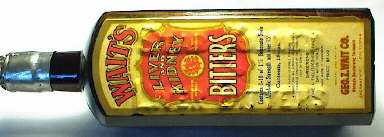 4. The same bottle could have been recycled and reused many times for many years before finally being discarded - entire or broken (Busch 1987; see link below). This was almost universal with many beverage bottle types (e.g., soda, beer, milk) but was variably common with just about any type bottle - especially prior to 1920. Of course, soda & beer bottles were reused up until quite recently; milk bottles beyond the mid-20th century. The bottle pictured to the right has a Wait's Liver and Kidney Bitters label pasted over the embossing of a Star Kidney and Liver Bitters bottle! (The two products were from separate companies which were cross-town [Sacramento, CA.] rivals during the late 19th to early 20th century. The author has also seen Star Bitters labels on Wait's bottles as well as both labels on the immensely period popular Hostetter's Stomach Bitters bottles!)
4. The same bottle could have been recycled and reused many times for many years before finally being discarded - entire or broken (Busch 1987; see link below). This was almost universal with many beverage bottle types (e.g., soda, beer, milk) but was variably common with just about any type bottle - especially prior to 1920. Of course, soda & beer bottles were reused up until quite recently; milk bottles beyond the mid-20th century. The bottle pictured to the right has a Wait's Liver and Kidney Bitters label pasted over the embossing of a Star Kidney and Liver Bitters bottle! (The two products were from separate companies which were cross-town [Sacramento, CA.] rivals during the late 19th to early 20th century. The author has also seen Star Bitters labels on Wait's bottles as well as both labels on the immensely period popular Hostetter's Stomach Bitters bottles!)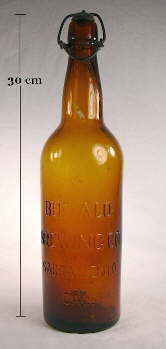 This Bottle Dating page (and website in general) is designed to address what the website author refers to as "utilitarian" bottles & jars (click for more information). Utilitarian items makes up the bulk of the bottles produced during the 19th century and first half of the 20th century.
This Bottle Dating page (and website in general) is designed to address what the website author refers to as "utilitarian" bottles & jars (click for more information). Utilitarian items makes up the bulk of the bottles produced during the 19th century and first half of the 20th century. 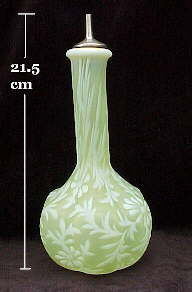 The dating guidelines found on these Dating Pages (and the entire website) do not always work well with what the author calls "specialty" bottles (click for more information). This is because certain classes of these bottles were often made using glassmaking techniques from earlier times or with methods not used for utilitarian ware. For example, some bottle types which were intended to be kept indefinitely (like the early 20th century barber bottle pictured to the right) were produced with the use of pontil or punty rods leaving telltale pontil scars on bottles into at least the early 20th century. The base image below left is of an late 19th to early 20th century barber bottle base with a very distinct blowpipe pontil scar with a little residual iron from the pontil rod. Another exception example is that the bottles for expensive, limited production liquors (e.g., high end cognac) and perfumes are still being hand-blown with tooled finishes.
The dating guidelines found on these Dating Pages (and the entire website) do not always work well with what the author calls "specialty" bottles (click for more information). This is because certain classes of these bottles were often made using glassmaking techniques from earlier times or with methods not used for utilitarian ware. For example, some bottle types which were intended to be kept indefinitely (like the early 20th century barber bottle pictured to the right) were produced with the use of pontil or punty rods leaving telltale pontil scars on bottles into at least the early 20th century. The base image below left is of an late 19th to early 20th century barber bottle base with a very distinct blowpipe pontil scar with a little residual iron from the pontil rod. Another exception example is that the bottles for expensive, limited production liquors (e.g., high end cognac) and perfumes are still being hand-blown with tooled finishes. 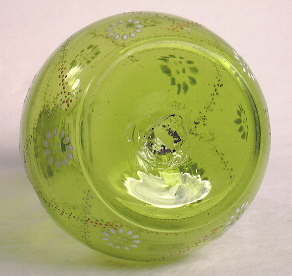 Specialty bottles include a significant number of bottles in the following categories: barber & fancy hair tonic bottles (pictured to left and right), perfume & cologne bottles, inkwells (not ink bottles; see ink bottles), fire "grenades", large display or advertising versions of regular sized bottles, demijohns and carboys or other large storage bottles, druggist "shop furniture", fancy or figural wine and liquor bottles, fancy liquor decanters and related bar bottles, and reproductions of earlier bottles (McKearin & Wilson 1978; Jones & Sullivan 1989; empirical observations). Many specialty bottles were imported from Europe, though that fact may be at times hard to impossible to ascertain. Specialty bottles can be, of course, occasionally found on historic sites (usually fragments, but occasionally intact) but can rarely be used to help date the site because of the diagnostic problems and deposition lag issues noted above.
Specialty bottles include a significant number of bottles in the following categories: barber & fancy hair tonic bottles (pictured to left and right), perfume & cologne bottles, inkwells (not ink bottles; see ink bottles), fire "grenades", large display or advertising versions of regular sized bottles, demijohns and carboys or other large storage bottles, druggist "shop furniture", fancy or figural wine and liquor bottles, fancy liquor decanters and related bar bottles, and reproductions of earlier bottles (McKearin & Wilson 1978; Jones & Sullivan 1989; empirical observations). Many specialty bottles were imported from Europe, though that fact may be at times hard to impossible to ascertain. Specialty bottles can be, of course, occasionally found on historic sites (usually fragments, but occasionally intact) but can rarely be used to help date the site because of the diagnostic problems and deposition lag issues noted above.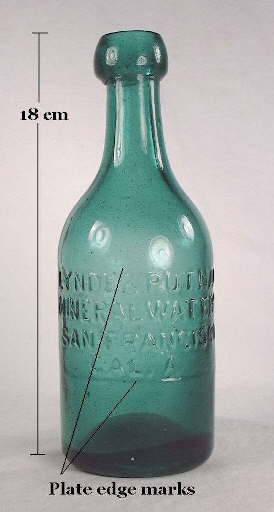 Raised embossing (and when present, paper labeling) on a bottle can frequently provide important details to refine the probable manufacturing date range if information exists for the company that either manufactured the bottle (i.e., glassmaker marks) or had the bottle made for them (i.e., the buyer & user of the finished bottle). For example, the early San Francisco mineral water bottle pictured here is known to date between 1850-1851 based on the information provided by the embossing (company name embossed on the pictured side and the glass maker - Union Glass Works - embossed on the reverse) and research done by collectors (Markota 1994).
Raised embossing (and when present, paper labeling) on a bottle can frequently provide important details to refine the probable manufacturing date range if information exists for the company that either manufactured the bottle (i.e., glassmaker marks) or had the bottle made for them (i.e., the buyer & user of the finished bottle). For example, the early San Francisco mineral water bottle pictured here is known to date between 1850-1851 based on the information provided by the embossing (company name embossed on the pictured side and the glass maker - Union Glass Works - embossed on the reverse) and research done by collectors (Markota 1994). 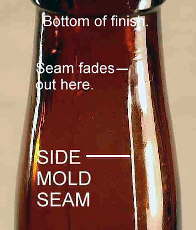
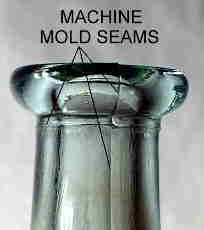
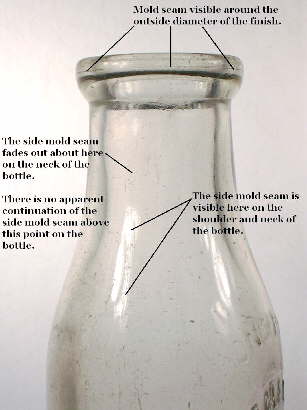 2. Milk Bottles - Many milk bottles made with press-and-blow machines from the very early 1900s into at least the 1940s resulted in vertical side mold seams that gradually fade out on the neck distinctly below the base of the finish. (Click here for a picture of a typical 1910s to 1940s milk bottle.) This exception to the side mold seam "rule" was caused by the specific workings of these machines which masked the upper portion of the side mold seam. These milk bottles will also virtually always have a diagnostic mold seam horizontally encircling the outside of the finish and a distinct valve/ejection mark on the base. Click on the image to the right to view both mold seam features pointed out on a press-and-blow machine manufactured milk bottle made by the Pacific Coast Glass Company (San Francisco, CA.) between 1924 and 1930. (For more information and images of typical milk bottles from that era, including an explanation of why the side mold seams fade out on the neck, go to the Food Bottles & Canning Jars typology page.)
2. Milk Bottles - Many milk bottles made with press-and-blow machines from the very early 1900s into at least the 1940s resulted in vertical side mold seams that gradually fade out on the neck distinctly below the base of the finish. (Click here for a picture of a typical 1910s to 1940s milk bottle.) This exception to the side mold seam "rule" was caused by the specific workings of these machines which masked the upper portion of the side mold seam. These milk bottles will also virtually always have a diagnostic mold seam horizontally encircling the outside of the finish and a distinct valve/ejection mark on the base. Click on the image to the right to view both mold seam features pointed out on a press-and-blow machine manufactured milk bottle made by the Pacific Coast Glass Company (San Francisco, CA.) between 1924 and 1930. (For more information and images of typical milk bottles from that era, including an explanation of why the side mold seams fade out on the neck, go to the Food Bottles & Canning Jars typology page.)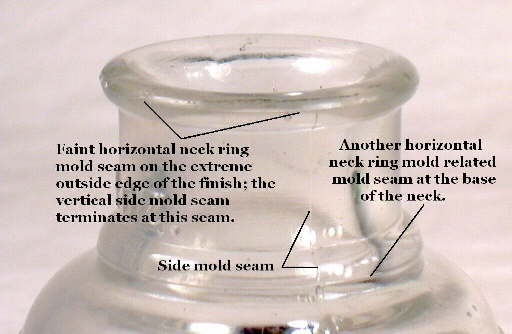 3. Ink/shoe polish bottles - Another common exception to this dating question deals with small ink bottles and similar small, moderately wide bore (mouth) bottles like shoe polish made during the first third of the 20th century.
3. Ink/shoe polish bottles - Another common exception to this dating question deals with small ink bottles and similar small, moderately wide bore (mouth) bottles like shoe polish made during the first third of the 20th century. 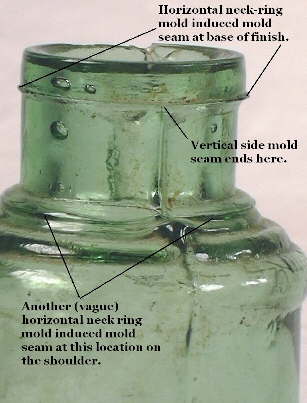 The image to the right is a close-up of a small, medium green, machine-made ink bottle. It has a similar ring/blank mold related mold seam features except in this somewhat earlier (late 1890s to 1910s) ink the side mold seam ends distinctly at the base of the finish, not within the finish itself like the above colorless example. As above, click on the image to view a larger and much more readable version with the various features pointed out.
The image to the right is a close-up of a small, medium green, machine-made ink bottle. It has a similar ring/blank mold related mold seam features except in this somewhat earlier (late 1890s to 1910s) ink the side mold seam ends distinctly at the base of the finish, not within the finish itself like the above colorless example. As above, click on the image to view a larger and much more readable version with the various features pointed out.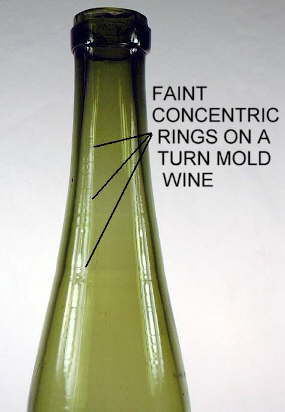

0 thoughts to “Amber switzer dating app”